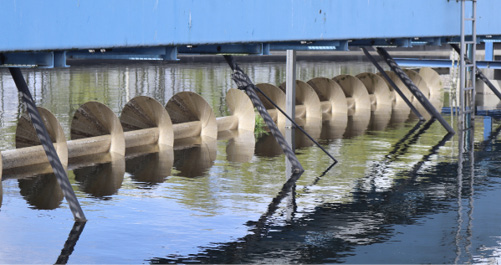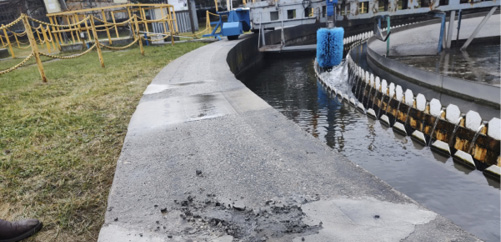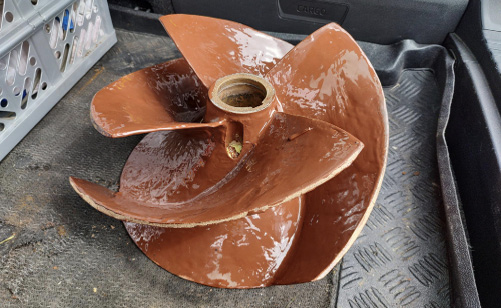Asset Management Strategies For Water Treatment Plants.
Edited by Mark S. Kuhar
Water treatment plants face significant challenges in maintaining aging infrastructure while meeting stringent environmental regulations. Asset management strategies play a pivotal role in ensuring uninterrupted operation, minimizing costs and extending the life cycle of critical equipment. In this article, we delve into Castolin Eutectic technologies to address common asset integrity issues.

Address Repairs Quickly
Any water treatment plant disruption can lead to untreated discharge, posing risks to water quality and ecosystems. Fast repairs help minimize downtime, ensuring continuous treatment and preventing environmental harm. Swift repairs also reduce the extent of damage and prevent secondary issues. For example, a small crack in a tank can escalate into a major leak if left unaddressed. Fast-setting products minimize the repair area, saving costs on materials, labor and potential emergency repair.
Heavy loads on equipment (e.g., sludge pumps and mixers) along with hydraulic stress through piping and valves and vibrational stress from rotating machinery can lead to rapid deterioration of equipment. Rapid repair and in-situ solutions are a cost-effective measure to prevent further deterioration and costly equipment failure.
During emergency repairs, such as addressing leaks and cracks in steel components like motor shafts and bearing sets, swift action is essential. Utilizing fast-curing repair pastes like MeCaFix 100 enables operators to quickly restore components to their original geometry, minimizing downtime and extending service life. MeCaFix 100 is a unique blend of polyurea and polyurethane to form a metal repair composite that cures 10 times faster than traditional fast-setting epoxy repairs.
When it comes to leak repairs, MeCaWrap W4 is the ultimate in fast setting solutions. MeCaWrap W4 is a water-activated composite wrap that provides pressure resistance up to 400 psi and allows for a return to service in under 10 minutes.
Managing Wear Loss on Critical Components
Clarifiers are an integral part of the treatment process. Both primary and secondary clarifiers experience deterioration and wear on critical components. These structures are particularly vulnerable to damage from the cyclic stress exerted by the scraper bridge wheels, leading to significant friction and load. The rake arm bears considerable weight from the scraper system – a substantial steel framework equipped with a rubber scraper that directs sludge to a discharge pit for removal.
The constant movement of the scraper’s wheels along the same path on the tank’s edge, combined with a corrosive environment, initiates wear, especially at weaker points such as joints or areas with varying texture or elevation. This initiates a cascade of wear, accelerating as loose sand and aggregate are dislodged from the concrete, potentially leading to operational issues like bridge misalignment or damage.
Selecting durable materials for weir repair is crucial for long-lasting results. Castolin Eutectic’s MeCaWear ceramic polymers involves restoring the tank rim with wear resistant products designed for resilience against heavy cyclic stress and chemical exposure.
For example, MeCaWear ceramic polymer compounds is a proven solution which adheres well to concrete and provides a durable surface resistant to scraper wheels. The choice of compound, such as MeCaWear 306 – a two-component silicon carbide novolac polymer – depends on various factors including underlying material and repair timeline. This product forms a protective barrier against wear, corrosion, and chemical attack, featuring a paint-like viscosity for easy application. While comprehensive resurfacing is ideal for uniform wear protection and extended maintenance intervals, budget constraints sometimes necessitate targeted patch repairs.
The effluent system consists of a V notched weir that is attached to the effluent launder. The weir and launder must remain clean and free from algae growth. Protecting the weir and lining the trough with MeCaWear 306, improves the cleaning operation. MeCaWear 306 is modified with surface clean technology that prevents buildup and accumulation on the coating surface.

Repair and Reinforcement of Cast Iron Components
In the realm of water treatment plants, cast iron components endure significant wear and tear, posing challenges for operational efficiency and longevity. Pumps, valves and pipework are exposed to a relentless influx of abrasive materials carried within wastewater streams. These materials, ranging from gritty sands to abrasive solids, gradually erode surfaces, necessitating proactive maintenance and protective measures.
Among the most susceptible components are pump impellers, especially those deployed at inlet works tasked with handling raw sewage. Laden with abrasive grit, sand and debris, these impellers bear the brunt of wear, requiring frequent upkeep to mitigate performance degradation. Similarly, sludge pumps contend with fine sands within the slurry, accelerating wear on impeller bodies and compromising operational efficiency.
To combat excessive wear in cast iron components, a two-pronged approach involving rebuilding and surface reinforcement is often adopted. By restoring components to their original dimensions and fortifying surfaces with durable ceramic-based coatings, the operational lifespan of pumps and valves can be extended by up to five years. Crucially, the application of ceramic coatings ensures optimal performance without impeding flow rates or energy efficiency, with application methods ranging from brush application to advanced spray technologies.
Illustrating this approach is a recent case where a cast iron pump impeller, exhibiting signs of cavitation and erosion, was meticulously rebuilt to rectify material loss and reinforce blade edges. Employing a Castolin Eutectic wear-protection solution, the impeller’s service life was notably extended, surpassing initial expectations by 50%.
Similarly, a non-return valve (NRV) faced challenges from abrasive particles and corrosive compounds within the flow stream. Through meticulous surface preparation and application of a 1-mm (40 mils) MeCaTeC ceramic polymer coating, the valve and associated pipework were shielded from abrasion, erosion, and corrosion, enhancing longevity and performance.
Concrete Tank Repair and Performance Lining
Internally, tanks also require maintenance to address cracks and deficiencies in concrete structures, posing risks of environmental contamination through untreated leakage. Cracks, often deepened by exposure to aggressive chemicals, moisture and biological agents, lead to deterioration of structural integrity, leaks and compromised operational performance.
Fluctuations in temperature stress materials, leading to expansion and contraction. Concrete structures crack and joints weaken. Additionally, weather conditions such as rain, snow, wind, and humidity affect infrastructure integrity, leading to corrosion and surface wear.
Chemical attack and physical erosion, demand meticulous repair strategies. Products like MeCaFix 140, a Kevlar reinforced polymer compound, offer a robust solution for non-structural defects, effectively filling voids and resurfacing damaged areas.
Composite systems injunctions with carbon fiber or glass fabric are an ideal reinforcement solution when required. Castolin Eutectic provides project-specific engineered solutions tailored to the needs of the end user and project conditions.
Installing a primary lining onto the tank surface such as MeCaCorr 706, is a cost-effective preventive solution that is designed to mitigate further attack of the concrete structure. MeCaCorr offers lining solutions for anaerobic digestion at elevated storage as well primary relining of the tank surface.

Conclusion
Navigating asset management challenges in WWTPs requires innovative solutions. By leveraging Castolin Eutectic’s technologies, operators can enhance asset integrity, reduce maintenance costs, and contribute to sustainable wastewater management. These products represent a paradigm shift in asset protection, ensuring the longevity of critical equipment and infrastructure.
Ultimately, the degradation of concrete, iron, and steel in wastewater facilities doesn’t necessitate complete replacement. Specialist wear-protection engineering can restore components to their prime condition, minimizing downtime and ensuring sustained operation.
Information for this article courtesy of Castolin Eutectic GmbH.
